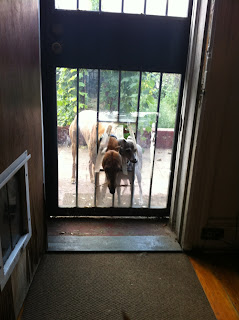
Arthur was locked in a cage for the first nine years of his life, fed in his cage and never walked. Obviously, he is a bundle of deprivation issues, fears, and generalized anxiety. We feel honored to have the challenge of teaching him to relax and trust, and nothing is more heartwarming than to introduce him to all of the little wonders, pleasures, and comforts of the world.
Every day weve seen him progress in leaps and bounds, as weve instilled consistent rules, boundaries, and rewards for a calm, trusting mindset. Below is a list of some of Arthurs behaviors that have already changed for the better, along with some others we hope to see soon. If your dog has fear/anxiety or trust issues, you might recognize many of these from your own situation.
- Eating/drinking. A dog in the highest state of fear wont eat or drink. Arthur displayed this only for the first day. Make sure your dog will seek food and water with you right next to the bowl as well as when youre out of the room.
- Peeing/pooping. This activity puts the dog in a vulnerable state, which means he has to trust that his environment is safe. (Thats why you see some dogs running behind bushes to poop, as if embarassed.) Arthur now goes in the yard but not yet on walks through the busy city.
- Lying down/relaxing. Left to his own devices Arthur spins in circles, filled with anxiety and not knowing where to channel the energy. Although he cuddled up the first night on our comforter in bed (and shook like a leaf when we started to get up in the morning), it took two days and lots of consistent discipline and calming exercises until he lay in his little bed on his own and shut his eyes.
"But the little guy isnt using it!" - Sniffing/exploring. Arthur didnt sniff another dog (even ours) for the first two days, and still hasnt sniffed a tree or bush. Smell is the most primal way dogs get information about their environment; even sighthounds need to sniff their surroundings. If your dog isnt sniffing your environment, things you pass on your walks, and other dogs and people, he just isnt being his full doggie self.
- Calm loose-leash walking. Arthur pulled and spun like crazy on leash at the beginning, but since we already have a calm obedient pack he learned quickly by the others example. If your dog pulls on the leash it means he doesnt see you as the source of all the good things in his life - and although that might sound selfish, it is essential in treating fear/anxiety as well as other problems like hyperactivity and aggression. Remember to always keep the leash loose, and make sure youre always in your dogs peripheral vision. Walk through busy streets, parks, night, day, rain ... the more variety of experiences you lead your dog through, the more hell trust, respect, and love you for showing him the world!

"I dunno about all this rainy stuff...
I hope Daddy knows what hes doing!" - Coming to you. Recall is of course an essential safety command to teach any dog. But even before that your dog has to feel comfortable being near you of his own accord. To do this always be a calm, confident, and welcoming guest when your dog comes near; applaud, use high-pitched verbal praise (weve been cheering "Yay!" so much the neighbors must wonder what sporting event were hosting over here). Pull him close - Arthur would initially maintain a good six food radius from anyone who reached for him. It is your job to show him that coming right next to you is safe, fun, and not an end to his freedom - so instantly release him to go free. Practice indoors and out; Arthur made huge trust and obedience progress when we practiced recall yesterday at the park on a 40-foot leash.

Watching his cousins relax in Prospect Park - Being alone. A self-confident dog should feel comfortable staying in a room while you leave and come back (without being told to "Stay"), and if you have a yard or garden should enjoy going out on his own and sniffing and exploring. We introduced Arthur to the yard by leading him through it and all around on leash, then made use of his need to pee by not going out with him, so he gained confidence that he could take care of business on his own.
- Barking. Not all, but most, dogs do it - and Arthur just started barking today! Hes "gained his voice" in a literal and metaphorical sense, feeling more at home, bolder in his skin, and more a part of a pack its his duty (he thinks) to protect. His favorite activity is now letting everyone who walks past the window know they better keep on movin!
- Playing. Dogs are playful creatures, but only do play when relaxed and happy. Just yesterday Arthur played with what the shelter told us is his favorite yellow squeaky slipper, chasing it and going crazy with tug-o-war! And today he chewed a Bully stick all day long.
 |
| Traffic jam at the doggie-door! |
 |
| New guard post. With official-looking cigar. |
 |
| "Im little but Im tough!" |
 |
| "Mine." |
Categories:
